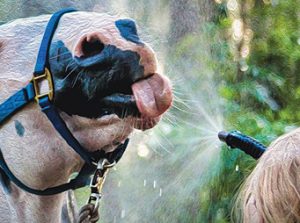Electrolytes, Sweating, and Anhidrosis in Horses
Click here to read the complete article458 – October, 2018
By Heather Smith Thomas
 The horse’s skin is an amazing organ. It protects the body (keeping the internal parts safe from outside dangers and external injury) and contains hair follicles, oil glands (to keep the hair healthy, and the skin moist and pliable instead of dry and scaling), and sweat glands. Horses have more sweat glands than any other mammal.
The horse’s skin is an amazing organ. It protects the body (keeping the internal parts safe from outside dangers and external injury) and contains hair follicles, oil glands (to keep the hair healthy, and the skin moist and pliable instead of dry and scaling), and sweat glands. Horses have more sweat glands than any other mammal.
Horses sweat for many purposes, and the sweat expelled from the sweat glands contains many substances besides fluid. Laura Petroski, Staff Veterinarian, Kentucky Equine Research (KER), says horses release pheromones via the sweat, and excrete waste products in their sweat, as well as cool the body by sweating. The output from sweat glands is controlled by a combination of factors. “Nerves, hormones, and proteins are the main players that induce and control the release of sweat,” she says.
Blood supply to the skin in these areas is abundant, and the blood vessels are very efficient at redistributing blood flow within the skin. “Horses can rapidly modify blood flow to sweat glands. The hormones and proteins that activate sweat glands are transported in the blood,” she explains. Fluid can also be rapidly moved from the bloodstream into the sweat glands.
WHY DO HORSES SWEAT?
“Horses sweat in response to increases in their internal temperature (such as a fever), excitement, pain, motor neuron disease, and metabolic disorders, specifically an inability to regulate blood insulin levels. Horses tend to sweat when stressed or in pain, as when they are colicking or tying-up,” she says.
Horses generally sweat as soon as their internal temperature begins to increase or when their bodies recognize that the temperature in the environment is greater than their internal temperature. “Normal resting internal temperature for horses is about 99° F. In hot conditions at rest, they have a gradual increase and a gradual decrease in the amount of sweat they produce,” says Petroski.
When the horse exercises, sweat output is considerably higher regardless of the outdoor temperature. “Horses begin to sweat at the start of exercise, and the sweating rate can still be increasing at the end of the workout. Sweating rate is correlated with ambient temperatures, skin temperatures, and exercise,” she explains. When the horse exercises, working muscles produce heat as a byproduct of energy production and movement, and this heat must be dissipated from the body.
Click here to read the complete article458 – October, 2018










